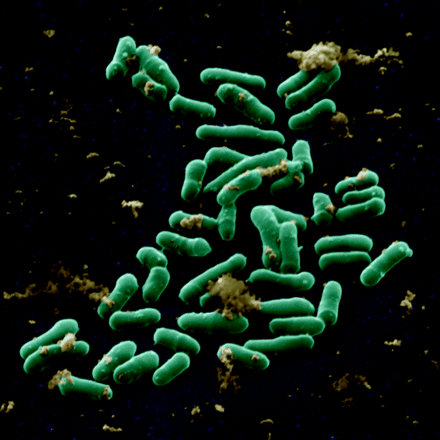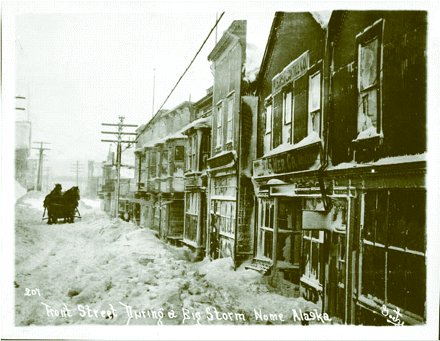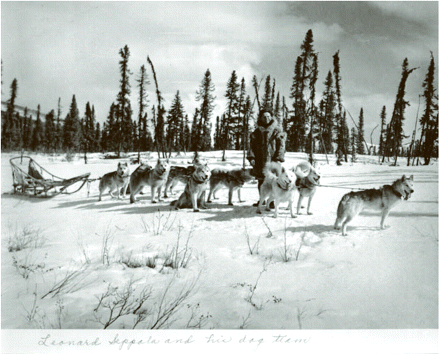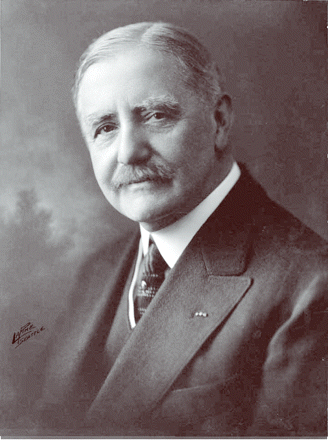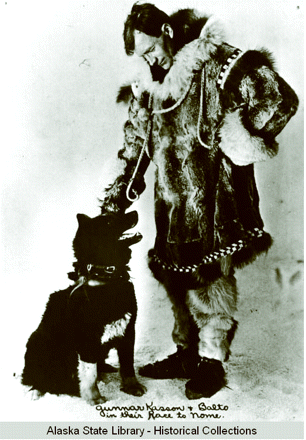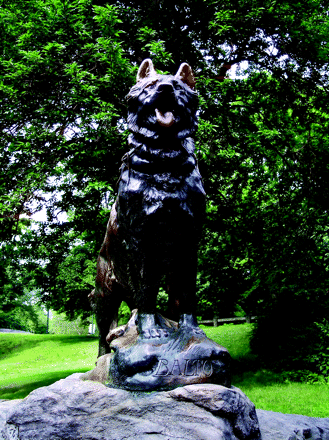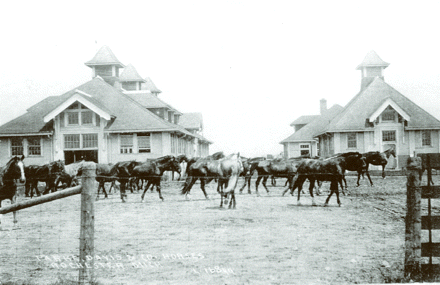The Drug That Launched A Thousand Sleds
When discussing the historical development of medicinals, diphtheria antitoxin likely does not first come to mind. Why celebrate, or even talk about, a 113-year-old biologic that became medically obsolete some seventy-five years ago? In the history of this life-saving remedy, two remarkable events are particularly noteworthy. First, in 1925, all America followed with bated breath a desperate “race with death” to bring supplies of the antitoxin to ice-bound Nome, Alaska, in time to abort an epidemic. Second, something little-known but of major importance occurred thirty years before the Nome episode. During the “gay nineties” and the early years of the twentieth century, diphtheria antitoxin played a crucial role in the emergence of a science-based pharmaceutical industry in the United States.
Nome, Alaska: Setting the Stage
Situated two degrees (ca 140 miles) south of the Arctic Circle, Nome first gained notoriety when, at the end of the 1890s, a single nugget of gold was discovered in a nearby creek. By the early 1920s, the gold rush was over and Nome’s population decreased to about 1,400. Some 10,000 Eskimos and other Alaskans lived nearby in villages and small mining camps scattered about the Seward Peninsula. Another Eskimo population lived on the Sandspit, a sandbar at the mouth of the Snake River, about 1.5 miles away (1).
Nome’s winter is seven months long. When the Bering Sea freezes at the end of October, Nome is cut off from Seattle, the nearest port. In the 1920s, there was no air service; experimental mail flights were limited to the summer months. The only usable route in winter was a dogsled trail through Alaska’s interior to the ice-free ports in the southeast. When the last boat before the freeze unloaded its cargo and steamed away, the people of Nome were on their own for the winter (1).
Medical care in Nome was rendered by Dr. Curtis Welch, assisted by his wife Lula (nee James) who served as his office nurse and anesthetist. The Welches lived in a corner apartment above a bank on Front Street, which ran parallel to the sea (1). An acerbic description of the couple is recorded in a letter written, in September, 1926, by nurse Gertrude Fergus, who had met the Welches in the summer of that year. She saw Dr. Welch as a “queer, fidgety little man with a shock of white hair...[a] very red, sunburned face, tummy like Santa Claus... and a flow of very expressive and explosive language....” Lula was “tall, dark, and rather dictatorial...a rather overbearing personality” (2). Although Fergus’s testimony might not make us eager to socialize with Dr. Welch, the record shows that he was deeply devoted to his community’s health.
During the summer of 1924, while making out his order for medical supplies, Dr. Welch found that his stock of diphtheria antitoxin was outdated; accordingly, he ordered a fresh batch. When his order arrived on the last boat before winter, the antitoxin was missing. This was worrisome, as the specter of diphtheria was always before him, especially when a child presented with tonsillitis. On the other hand, in his eighteen years of practice on the Seward Peninsula, he had never actually seen a confirmed case of the disease (1).
The Scourge of Diphtheria
Diphtheria was one of the first diseases investigated by the pioneers of bacteriology and by the latter part of the nineteenth century was quite thoroughly understood. It is caused by a bacillus, Corynebacterium diphtheriae, which secretes a potent exotoxin, causing high fever (102–104°F), marked prostration, and weakening of the heart. Although the bacterium does not invade the deeper body tissues, it tends to grow on the surface of the mucous membranes of the throat, nose, and larynx, producing a dirty-gray membrane that obstructs the patient’s breathing, compounding the destructive effects of the toxin. Even after recovery, there may be sequelae, such as difficulties in speech and swallowing, myocardial damage, paralysis, and nephritis (3). The foregoing objective description does not truly convey the horror the victim’s (usually a child between one and ten years old) “anxious, struggling, pitiful expression of impending suffocation” (1).
Diphtheria toxin, the first known bacterial exotoxin, was discovered in 1888. Shortly thereafter, the toxin was found to stimulate production of an antitoxin when injected into animals. By 1895, the antitoxin was successfully administered by injection to cure diphtheria patients. The public health effect was dramatic. For example, between 1888 and 1894, the death rate among diphtheria patients in Boston City Hospital fell below 40% only once. Between 1895 and 1925, when the antitoxin was in use, mortality never rose above 15% (4). Early administration of the antitoxin was essential. Data from Philadelphia showed that injection on day 1 or 2 of the illness restricted mortality to about one to three percent, whereas the death rate rose to above sixteen percent if injection was postponed to day 7. Between 1895 and 1928, when diphtheria toxoid was introduced (Box 1), it was not possible to prevent the disease, but it was possible to cure it by administering the antitoxin promptly.
Diphtheria Toxoid Production
Even during the heyday of diphtheria antitoxin, the search for a means of preventing continued, which led to a modified toxin, or toxoid. To make the toxoid, toxin is first produced by growing C. diphtheriae in a specially formulated culture medium. The toxin is then treated with formaldehyde, reducing its toxic potency but retaining its antigenic power. The toxoid thus formed is concentrated by ultrafiltration, precipitated with aluminum hydroxide, and purified by dialysis and sterile filtration (13). By about 1928, active immunization with diphtheria toxoid had supplanted antitoxin treatment of infection. Even today, this life-saving toxoid is taken for granted. Mixed with tetanus and pertussis vaccines in D-T-P, or as D-T-P plus polio and hepatitis vaccines (Pediarix®), it is administered to babies. By six months of age, infants develop active immunity against diphtheria and the two or four other infections covered by the combination product.
1925: Diphtheria Strikes Nome
The first hint of approaching trouble came in December, 1924, when an Eskimo child from a nearby village died, seemingly of tonsillitis. Two more children died subsequently, but the cause was not clear. Then, on January 20, 1925, Dr. Welch saw the typical gray, bloody lesions of diphtheria in the throat and mouth of a three-year-old boy. Afraid to use his outdated stock of antitoxin, he resorted to the old, nonspecific remedies; after a temporary improvement, the child died. The next day Welch saw another child, a seven-year-old girl, with unmistakable diphtheria. He immediately phoned the mayor, who summoned the Town Council into emergency session. On January 22, Welch fired off a telegram to the US Public Health Service in Washington, urgently requesting diphtheria antitoxin. Within one week, the diphtheria epidemic in Nome was front-page news all over the United States (1).
There was no shortage of diphtheria antitoxin in what are now the “lower 48,” but getting it to Nome was a formidable problem. Direct delivery from Seattle by ship was impossible, the Bering Sea being frozen. Inclement weather conditions made delivery by air too hazardous, given the open-cockpit planes then in use. The railroad went only as far as Nenana, a town in the interior of Alaska, 674 miles east of Nome. Council member Mark Summers, manager of Consolidated Gold Fields, proposed that this stretch be covered by two dogsled teams, one heading west from Nenana with the serum, the other heading east from Nome. The two teams would meet halfway, at Nulato, where the second team would retrieve the serum and return immediately to Nome.
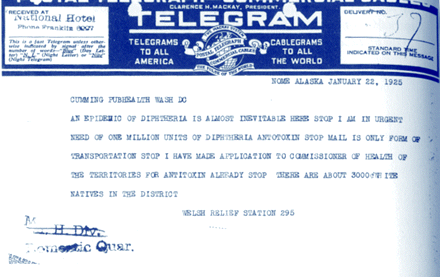
While plans were being drawn up, a physician in Anchorage, John Bradley Beeson (Box 2), reported that his hospital had 300,000 units of antitoxin on hand. This quantity could be dispatched immediately and might keep the epidemic in check until the main supply from the States could get to Nome. On January 26, Dr. Beeson put a twenty-pound package, containing the 300,000 units, on a locomotive leaving Anchorage. Twenty-four hours later, when the train arrived at Nenana, dogsled driver “Wild Bill” Shannon received it and started out on his westward trek.
Dr. John Bradley Beeson
Aside from his role in finding a stopgap supply of diphtheria antitoxin for Nome, Dr. Beeson was the hero of an earlier saga when he made a house call for a sick patient in 1921. The house call was notable, as it was 500 miles from his office! The patient was a banker in the small town of Iditarod. Beeson arranged an impromptu relay of dog teams to transport him from Anchorage to Iditarod. The terrain was so rough that the doctor had to be lashed to the sled for much of the trip. Examining the patient, Beeson diagnosed pulmonary tuberculosis and determined to get him to the hospital in Anchorage. A relay arrangement was not feasible in this case. Beeson was able to get the help of Leonhard Seppala, who would be one of the heroes of the 1925 Nome antitoxin relay. Seppala and his dog team, led by Togo, delivered the doctor and his patient safely to the hospital (1)
At the same time, the situation in Nome worsened dramatically, with more people becoming ill. Dr. Welch was especially frightened when a woman presented with diphtheria symptoms after visiting her father’s roadhouse a few miles outside Nome. Welch feared that every traveler passing through that roadhouse might have been exposed. Mayor Maynard frantically appealed for an airlift. He was seconded by many influential people, especially those who saw this as a good opportunity to bring aviation to Nome. However, Territorial Governor Scott C. Bone still felt that an airlift would be highly dangerous and uncertain of success. He steadfastly resisted all the pressure, but he did propose, and put into effect, a change from the original plan. Instead of one team going from Nome to Nulato and immediately returning to Nome, the Nulato-to-Nome distance would be covered by relays of dogsled teams, traveling day and night. The Governor ordered Mark Summers to organize this relay.
The cruel conditions faced by the twenty men and 150 dogs who participated have been told by Salisbury and Salisbury (1) and others. These men and dogs encountered furious winds, blizzards, ice fog (ice crystals suspended in the air), the “ice factory” of Norton Sound, where the ice is not a sheet of glass but undergoes constant upheaval, and unbearable cold. The sledders often broke the “Rule of the Forties,” which states that it is too dangerous to run dogs at temperatures below −40° F or above +40° F. They suffered hypothermia and frozen digits, but they persisted with no thought of giving up. It should be mentioned that these were men of widely different ethnic backgrounds, all working together in their selfless pursuit of a humanitarian goal.
The final segment of the journey, the last seventy-eight miles to Nome, was traversed by Gunnar Kaasen with Balto as the lead dog. Disregarding advice to wait, Kaasen set off in a blizzard with winds over seventy miles per hour. Balto’s sense of smell and tactile sense were crucial in helping the team find and keep to the trail, thereby avoiding fatal pitfalls. Kaasen was supposed to go only as far as Point Safety, twenty miles from Nome, but when he got there he found the next man in the relay asleep. In order to lose no time, Kaasen decided to continue. At 5:30 a.m. on Monday, February 2, Kaasen pulled up on Front Street in Nome. According to witnesses, he staggered off the sled, stumbled forward to embrace Balto and mumbled, “Damn fine dog,” before collapsing (1).
Despite heroic efforts to keep it from freezing (the possible effects of freezing were unknown at the time), the antitoxin was frozen when it arrived. By 11 a.m., Dr. Welch had it thawed and started administering it to his sickest patients. It turned out that freezing had no adverse effect on the antitoxin. Dr. Beeson had prevented cracking of the glass vials by using rubber and cork stoppers to counteract expansion.
As for the main shipment of antitoxin, Governor Bone agreed to permit half of it to be shipped by air while the other half went by dogsled. On February 15, in the midst of a blizzard, Ed Rohm with his lead dog Star delivered his half of the supply to Nome. The plane carrying the other half never got off the ground, owing to mechanical difficulties (1). The entire country rejoiced at the happy outcome of the race against the diphtheria menace. The men and dogs of the relay teams that brought Beeson’s serum to Nome were lionized. A statue of Balto was speedily erected in New York’s Central Park; its unveiling on December 16, 1925, was attended by Gunnar Kaasen as well as Balto (Box 3). It remains as a tourist attraction on East Drive at 67th Street.
What Happened To Balto and His Team?
Balto and his six team-mates were acquired by a vaudeville impresario and were taken on a circuit all around the country. They later wound up as a side-show attraction in Los Angeles. George Kimble, a Cleveland businessman, initiated a public campaign to rescue the dogs from this ignominious situation. With the money he collected, much of it donated by schoolchildren, he purchased the dogs. They were given a hero’s parade through downtown Cleveland and quartered at the Brookside Zoo in that city. Balto’s death in March, 1933, was noted in the press. His preserved body is on view at the Cleveland Natural History Museum (1).
A living memorial to the achievement of all those involved in the 1925 serum run to Nome is the Iditarod Trail Dog Sled Race, held annually in March. Organized in 1967 as a tribute, and also to preserve the tradition of dog sledding (mushing), the race follows a course of nearly 1,200 miles, from Anchorage to Nome.
Diphtheria Antitoxin and the Young Pharma Industry
Diphtheria antitoxin has been called the first science-based drug produced in the United States (5). The basic discoveries were made in Europe, the center of nineteenth-century bacteriology. Discovery and development of the antitoxin took place in Germany; Emil von Behring and Paul Ehrlich prepared it, at first in goats but later in horses, animals more suitable for large-scale production. They also devised a quantitative method and a stable reference standard for testing antitoxin potency (6, 7). By 1895, the antitoxin was used routinely for the treatment of diphtheria. Curing a deadly infection was indeed miraculous at a time when antibiotics and other anti-infectives were unknown.
When news of the successful cure of diphtheria reached the United States, it stimulated a clamorous demand for the remedy on the part of the American public. Municipal public health departments in cities such as New York and Philadelphia were the first to undertake research in this field and to produce and supply the antitoxin. After a short time, they left production to the private sector and began focusing on regulatory functions and widespread immunizations (8). In three major cities, research-based pharmaceutical companies developed as a result. In New York, Lederle Laboratories grew out of the work of the Public Health Department; in Philadelphia, Mulford, and in Detroit, Parke-Davis enlisted the expertise of faculty at leading US universities to support and supplement their efforts.
New York: Park and Lederle
In 1894, Dr. William Park of the New York City Health Department set up a system of depots in the city, where doctors could obtain kits for diagnosing and recording cases of diphtheria. That same year, his supervisor, Dr. Herman M. Biggs, visited the Koch Institute in Germany and observed the preparation of diphtheria antitoxin. Park and his colleagues soon succeeded in preparing sera even more potent than those in use in Europe. On New Year’s Day 1895, Park’s antitoxin was first used to treat two diphtheria patients in New York (8).
As more antitoxin was produced, the Health Department supplied it free to New York City’s poor and sold it to other cities and to the general drug trade. At that time, antitoxin imported from Germany was in short supply, costing $12 per dose. At first, the health department’s operation was hailed, but other would-be suppliers soon began criticizing the department for competing with private enterprise. In 1902, a petition signed by a thousand doctors and druggists was presented to the mayor of New York. As a result, the Department scaled back its operations and stopped distributing antitoxin outside of New York City (9).
One of Park’s associates in the Health Department was Ernst J. Lederle (1865–1921). A PhD chemist working for the Department since 1888, Lederle was responsible for many public health improvements. He confirmed that tuberculosis could be acquired from milk, leading to the requirement that all milk sold in New York City had to come from tuberculin-tested cows. He carried out an emergency mass smallpox vaccination; as a result, whereas there were 309 deaths from smallpox in 1902, there were only four in 1903. He instituted weekly eye and skin examinations of all pupils by school doctors. He waged a continuing campaign for pure milk, water, and food. Perhaps not surprisingly, he was removed from his position of authority following a Tammany Hall election victory in 1903 (9).
Leaving the Health Department in 1904, Lederle opened a commercial laboratory performing chemical, bacteriologic, and sanitary analyses. In 1906, noting the growing demand for the pure, standardized diphtheria antitoxin developed by Park, he incorporated Lederle Antitoxin Laboratories and began manufacturing the product using horses quartered in a veterinary hospital in the city. One year later he purchased a ninety-nine-acre farm at Pearl River, New York, a town thirty miles away. Production of diphtheria antitoxin was transferred there, and tetanus antitoxin and typhoid vaccine shortly were added (9).
Lederle Laboratories, after gaining recognition for biologics, branched out into discovery and development of new drugs, vitamins, and antibiotics. Acquired by American Cyanamid in 1930, it reached its zenith, in the 1940s, with two great achievements. First came the extraction and large-scale synthesis of a new vitamin folic acid and the discovery of medically important folate derivatives, such as methotrexate. The second major Lederle coup was the discovery of chlortetracycline (Aureomycin), the first broad-spectrum antibiotic, by seventy-five-year-old Benjamin Duggar, a botany professor recruited by Lederle after he was put out to pasture by the University of Wisconsin.
Ultimately, in 1994, Lederle and Cyanamid were acquired by Wyeth. Lederle no longer conducts cutting-edge research and is essentially a marketing arm of Wyeth. Its establishment, however, as one of the earliest research-driven American pharmaceutical companies, owes much to diphtheria antitoxin.
Philadelphia: McFarland and Mulford
Dr. Joseph McFarland, 26, had studied bacteriology at Heidelberg and Vienna and held part-time teaching posts in the Medical Department of the University of Pennsylvania in Philadelphia. At home one evening, in November of 1894, he received an unexpected visit from Milton Campbell and H.K. Mulford, President and Vice President of H.K. Mulford Company, a small local drug manufacturing firm. The two men made McFarland what he later described as an “amazing proposition” (10). They asked him to set up and direct a laboratory to manufacture diphtheria antitoxin. Assured that this would not impinge on his teaching duties, McFarland accepted. The terms of his employment were not reduced to a written contract, but were agreed to as an “understanding between gentlemen” (10). His salary was to be $100 a month (8).
A large stable in West Philadelphia was rented and converted into a laboratory, an incubation room, rooms for small animals, and quarters for the horses that would provide the necessary sera. McFarland engaged two assistants, one of them a professor of veterinary surgery at Penn. He and his staff were now ready to proceed, although none of them were experienced. McFarland turned to New York for assistance to William H. Park and to Dr. Gibier of the New York Pasteur Institute (Box 4). He received invaluable advice, as well as essential cultures, from Park (10).
New York Pasteur Institute

Americans were quick to appreciate the importance of Pasteur’s discoveries on rabies. Only six months after Pasteur had treated his first patient, four boys who had been bitten by a rabid dog, were sent from Newark, NJ, to Paris for treatment, their expenses paid by contributions from the public. Their return home in January 1886, to a hero’s welcome, caused a stir in the local and national press. America expressed its enthusiasm over Pasteur’s rabies treatment by establishing, between 1890 and 1908, ten Pasteur Institutes across the country, although these were not official satellites of the Institute in Paris as were founded elsewhere in the world by Pasteur’s students and colleagues. The Institute in New York was founded by Dr. Paul Gibier, who had done a doctoral thesis on rabies in Paris. After Gibier’s accidental death in 1900, the Institute was directed by his American nephew George Gibier Rambaud. Dr. Rambaud closed the Institute in 1918 when he was posted overseas by the US Medical Corps. None of the American Pasteur Institutes survive, and their existence has been largely forgotten (14).
Still, the project did not go smoothly. It took months to optimize the composition and pH of the culture media. Glassware failed to meet the required specifications, and was thus unusable. Contamination was an ongoing problem, much of it owing to tetanus spores which naturally abound in a stable. The horsy redolence of the building became unbearable in the winter, when all windows were tightly closed, and the unmistakable odor accompanied McFarland’s staff on their journeys home by streetcar. McFarland described life during this period as “full of thrills” (10).
Nevertheless, perseverance and good scientific work carried the day. In the early summer of 1895, the Mulford company offered its first diphtheria antitoxin for sale. McFarland’s reward was four months off, with full pay, to visit European state-of-the-art laboratories. The next biologic successfully developed by McFarland was tetanus antitoxin. Although he left Mulford after two years for a full-time professorship, the firm went on to become a major producer of vaccines and a leader in their standardization. When the 1902 Biologics Control Act went into effect, Mulford received Biologics License No.2 (8). In 1925, Mulford hit the front page of the New York Times, as it was Mulford’s antitoxin that was carried to Nome by dogsled (8).
Thus, a drug company that started as an outgrowth of a corner pharmacy in Philadelphia changed from punching out tablets into a developer of science-based products because its principals recognized and seized the opportunity offered by diphtheria antitoxin. After a time, Mulford was acquired by Sharpe and Dohme, which in turn merged with Merck. The Mulford history presaged Merck’s pre-eminence in the vaccine field.
Detroit: Houghton and Parke-Davis
Parke-Davis was founded in 1866 by S.P. Duffield, a chemist who had trained under Justus von Liebig, and by pharmacists Hervey Parke and George Davis. It was one of the first drug firms to institute a quality control laboratory (11). For a quarter of a century, its product line consisted of tablets, pills, and liquids containing the standard drugs and drug combinations of the time. Similarly, the Mulford Company had built its business around a patented tablet press on which they produced a popular line of water-soluble tablets (5).
The turning point for Parke-Davis came, as it had for Mulford, in 1894, when demand for diphtheria antitoxin grew acute. Transport of the serum, first from Germany across the Atlantic by steamship, and then from New York to Detroit by rail, was a time-consuming and costly affair. Parke-Davis brought in Elijah M. Houghton to develop diphtheria antitoxin. Houghton had degrees in pharmacy and medicine from the University of Michigan, and was teaching at the University. The twenty-seven-year-old Houghton joined Parke-Davis in 1894 and succeeded in producing the antitoxin within a year. He stayed with the firm, until 1929, as director of medical research and biological laboratories (5, 12). Parke-Davis went on to build close ties with the University of Michigan by supporting many graduate students and later hiring them (5).
Diphtheria Immunization Today
Diphtheria antitoxin is no longer even licensed in the US, although it can be obtained through the Center for Disease Control and Prevention under a Treatment IND. Its importance is far greater than its short life-span of approximately thirty-five years. Its legacy, unsurpassed in the history of modern public health initiatives, grew out of the dedication and cooperation of pioneers from diverse social spheres. This legacy is reflected in the commitment we see today, from academia, industry, and government, in the development and use of still-needed strategies to combat disease.
- © American Society for Pharmacology and Experimental Theraputics 2008
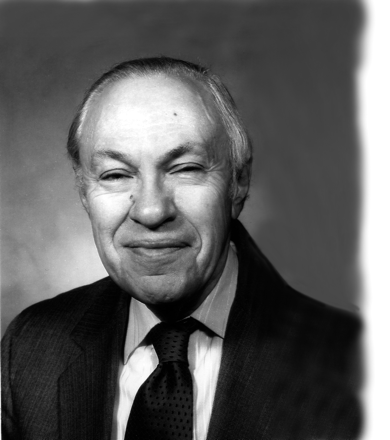
Stanley Scheindlin, DSc, holds a BS in pharmacy from Temple University and graduate degrees in pharmaceutical chemistry from Philadelphia College of Pharmacy and Science (now University of Sciences in Philadelphia). His academic research dealt with plant constituents and chemical interactions of vitamins. In his pharmaceutical industry career, he handled new drug formulation developments, and later regulatory affairs, presiding over the filing of about 100 generic new drug applications and two innovative drug applications. Now retired, his activities include volunteer work, consulting, and writing Reflections pieces for this journal.

